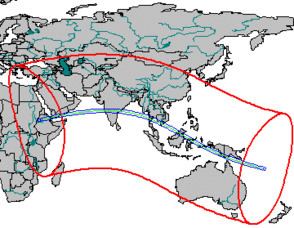Nature Total Magnitude 1.0756 Max. width of band 245 km (152 mi) Start date August 18, 1868 | Gamma -0.0443 Duration 407 sec (6 m 47 s) Greatest eclipse 5:12:10 | |
 | ||
A total solar eclipse occurred on August 18, 1868. A solar eclipse occurs when the Moon passes between Earth and the Sun, thereby totally or partly obscuring the image of the Sun for a viewer on Earth. A total solar eclipse occurs when the Moon's apparent diameter is larger than the Sun's, blocking all direct sunlight, turning day into darkness. Totality occurs in a narrow path across Earth's surface, with the partial solar eclipse visible over a surrounding region thousands of kilometres wide.
Contents
Captain Bullock observed from the Celebes sea, sketching the appearance of the corona, while Gustav Fritsch accompanied an expedition to Aden.
Discovery of helium
French astronomer Pierre Janssen observed the eclipse from Guntur in Madras State, British India. It was the first total eclipse since Gustav Kirchhoff's 1859 theory that the Fraunhofer lines in the solar spectrum correspond to the emission line of the different chemical elements present in the Sun. Correspondingly, Janssen observed the eclipse with the aid of a spectroscope. He noticed a bright yellow line (λ = 587.49 nm) in the spectra of the solar prominences that could not be due to sodium as had previously been assumed, and was subsequently able to observe the same line even without the need for an eclipse. The same result was found independently by British astronomer Norman Lockyer, and both Janssen's and Lockyer's communications were presented to the French Academy of Sciences on October 26, 1868.
King Mongkut's calculation
King Mongkut, also known as Rama IV of Siam, was able to calculate and predict the solar eclipse two years earlier. The calculations were correct as to the place, the time and the type of the solar eclipse that would happen. The eclipse took place precisely as the king had predicted, the total phase lasting six minutes and 46 seconds. In fact, his calculations were better — by about two seconds — than those of the French astronomers, who acknowledged his accuracy. Mongkut was exposed to malaria, then developed chills and fever. He died on October 1, 1868. According to the Thai Astronomical Society, the international astronomical community calls the eclipse "King of Siam's eclipse".
Related eclipses
It is a part of solar Saros 133.
